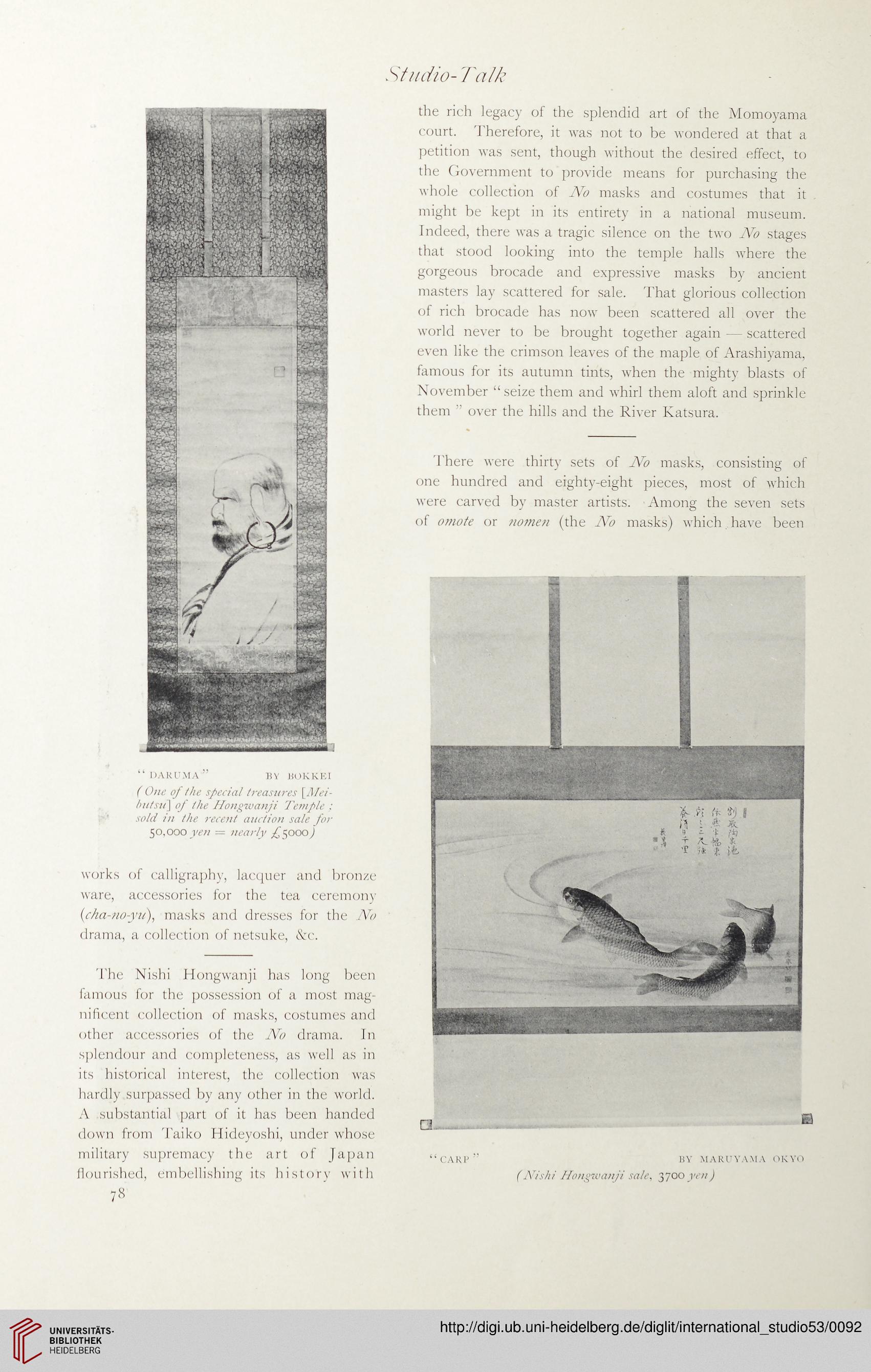Studio- Salk
“daruma” by bokkei
( One of the special treasures \Mei-
butsu\ of the Hongivanji Temple ;
sold in the recent auction sale for
50,000 yen = nearly ^5000J
works of calligraphy, lacquer and bronze
ware, accessories for the tea ceremony
(cha-no-yu\ masks and dresses for the No
drama, a collection of netsuke, &c.
The Nishi Hongwanji has long been
famous for the possession of a most mag-
nificent collection of masks, costumes and
other accessories of the No drama. In
splendour and completeness, as well as in
its historical interest, the collection was
hardly surpassed by any other in the world.
A substantial part of it has been handed
down from Taiko Hideyoshi, under whose
military supremacy the art of Japan
flourished, embellishing its history with
78
the rich legacy of the splendid art of the Momoyama
court. Therefore, it was not to be wondered at that a
petition was sent, though without the desired effect, to
the Government to provide means for purchasing the
whole collection of No masks and costumes that it
might be kept in its entirety in a national museum.
Indeed, there was a tragic silence on the two No stages
that stood looking into the temple halls -where the
gorgeous brocade and expressive masks by ancient
masters lay scattered for sale. That glorious collection
of rich brocade has now been scattered all over the
world never to be brought together again — scattered
even like the crimson leaves of the maple of Arashiyama,
famous for its autumn tints, when the mighty blasts of
November “seize them and whirl them aloft and sprinkle
them ” over the hills and the River Katsura.
There were thirty sets of A'b masks, consisting of
one hundred and eighty-eight pieces, most of which
were carved by master artists. Among the seven sets
of omote or nomen (the No masks) which have been
BY MARUYAMA OKYO
(Nishi Nongivanji sale, 3700 yen)
“carp ”
“daruma” by bokkei
( One of the special treasures \Mei-
butsu\ of the Hongivanji Temple ;
sold in the recent auction sale for
50,000 yen = nearly ^5000J
works of calligraphy, lacquer and bronze
ware, accessories for the tea ceremony
(cha-no-yu\ masks and dresses for the No
drama, a collection of netsuke, &c.
The Nishi Hongwanji has long been
famous for the possession of a most mag-
nificent collection of masks, costumes and
other accessories of the No drama. In
splendour and completeness, as well as in
its historical interest, the collection was
hardly surpassed by any other in the world.
A substantial part of it has been handed
down from Taiko Hideyoshi, under whose
military supremacy the art of Japan
flourished, embellishing its history with
78
the rich legacy of the splendid art of the Momoyama
court. Therefore, it was not to be wondered at that a
petition was sent, though without the desired effect, to
the Government to provide means for purchasing the
whole collection of No masks and costumes that it
might be kept in its entirety in a national museum.
Indeed, there was a tragic silence on the two No stages
that stood looking into the temple halls -where the
gorgeous brocade and expressive masks by ancient
masters lay scattered for sale. That glorious collection
of rich brocade has now been scattered all over the
world never to be brought together again — scattered
even like the crimson leaves of the maple of Arashiyama,
famous for its autumn tints, when the mighty blasts of
November “seize them and whirl them aloft and sprinkle
them ” over the hills and the River Katsura.
There were thirty sets of A'b masks, consisting of
one hundred and eighty-eight pieces, most of which
were carved by master artists. Among the seven sets
of omote or nomen (the No masks) which have been
BY MARUYAMA OKYO
(Nishi Nongivanji sale, 3700 yen)
“carp ”




